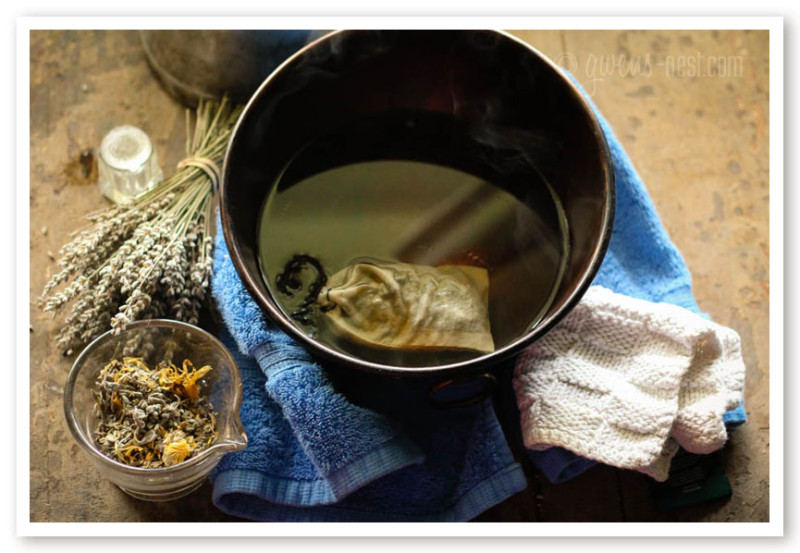
Postpartum care in the form of an herbal sitz bath-this bath tea is so soothing, smells lovely, and is very useful in recovering from birth. I recently discovered first hand that herbs are a wonderful addition to post-pregnancy care. This is the first time I’d tried herbal remedies after a birth, and my nurses and I were very impressed at how quickly I healed.
I made this Postpartum herbal sitz bath blend and used it in frozen compresses right after my son’s birth (while still in the hospital), and also used it in sitz baths, and in the peri bottle during my recovery at home.
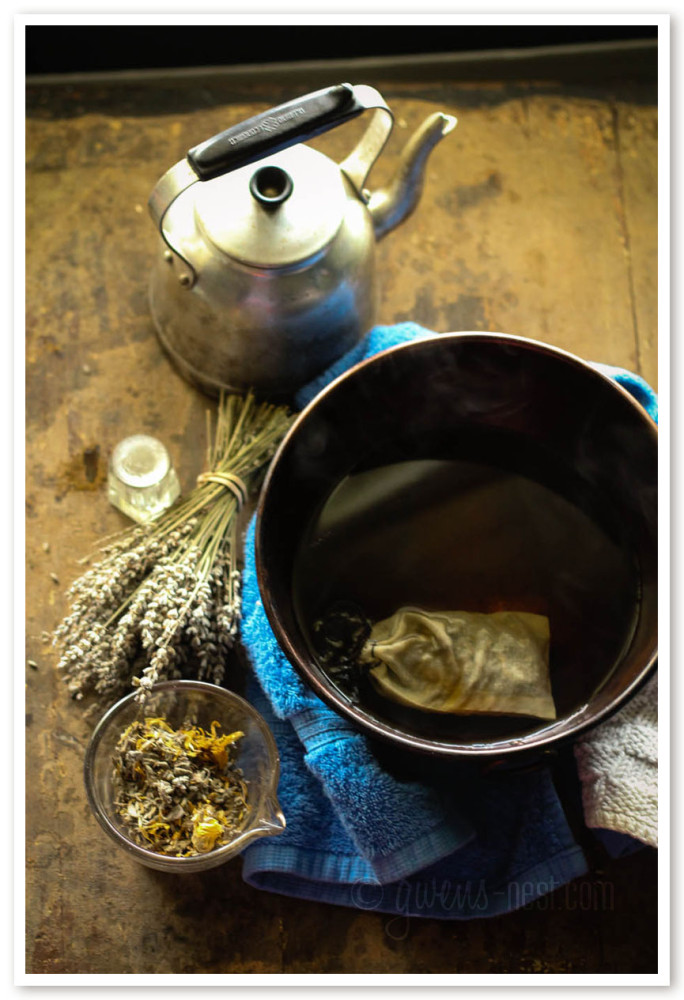
[bctt tweet=”An herbal sitz bath or peri bottle solution for postpartum recovery. It WORKS!”]
This turned out to be a really lovely blend, and it smells so soothing with the addition of the lavender flowers. Herbal recipes are very forgiving, and can be modified to use the herbs you have on hand. The key players here are toning and healing herbs: comfrey, shepherd’s purse, uva-ursi, and salt. The other ingredients simply enhance the main components, but are not critical to have in your mix. I harvested the lavender and chickweed out of my yard.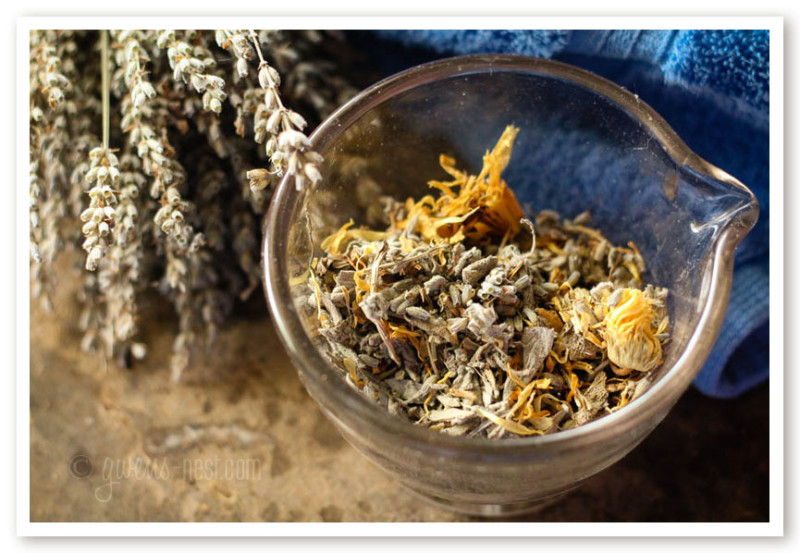
To make your own, I’ve provided the recipe I use below and resources for ordering the herbs.
If you’d prefer to have a more instant solution on hand, here is a wonderful herbal sitz bath tea concentrate or a loose leaf tea that’s all ready to go from Mother Love Herbals.
No matter what blend you use, I’ll show you exactly how to use them below.
Printable Postpartum Care Herbal Sitz Bath & Pin
You’ll find instructions on using this herbal sitz bath, plus a list of supplies links just below the printable recipe. It’s not necessary to use every single herb, so I list the actions below in the resources.
- 1 oz. comfrey leaf
1/2 oz. each of - rosemary
- shepherds purse
- sea salt
- uva-ursi
1/4 oz. each of - chickweed
- marshmallow root
- plantain
- lavender flowers
- sage
- yarrow
- calendula
- Blend herbs together and store in an airtight container in a cool, dry place.
- Yields about 2½ cups of Postpartum Tea.
- As with most herbal blends, you don't need to have *every* ingredient on hand...even simple blends of two to three herbs can be very soothing and healing. Comfrey, sea salt, & uva ursi are key players here.
To use in a regular bath: steep 1 cup of herbs in 2 cups boiling water for at least 20 minutes or overnight. Add to your bath water, and enjoy a relaxing soak.
You may use the peri bottle and sitz baths as many times a day as you’d like for comfort, but if you have stitches, limit your use of an herbal sitz bath to only once per day.
frozen postpartum compresses: Pour one batch of peri strength tea over disposable feminine pads until saturated. Freeze pads. Disposable/sterile pads are recommended for this use.
Cotton muslin bags would make excellent and simple tea bags that would be strong enough to use for a warm compress after brewing. There is a school of thought now that warm compresses can be even more soothing than cold after birth.
Postpartum Herbal Bath Tea Uses
There are many ways you can use this wonderful herbal bath tea blend. You can use it in the bathtub if you are so inclined, but I found that using it on compresses and in my peri bottle and sitz bath made it convenient and I used it more often in those ways. You may use the peri bottle as many times a day as you’d like for comfort. If you have stitches or broken skin, limit your use of an herbal sitz bath or full bath to only once per day (please consult with your midwife or doctor on time frames for bathing after birth.)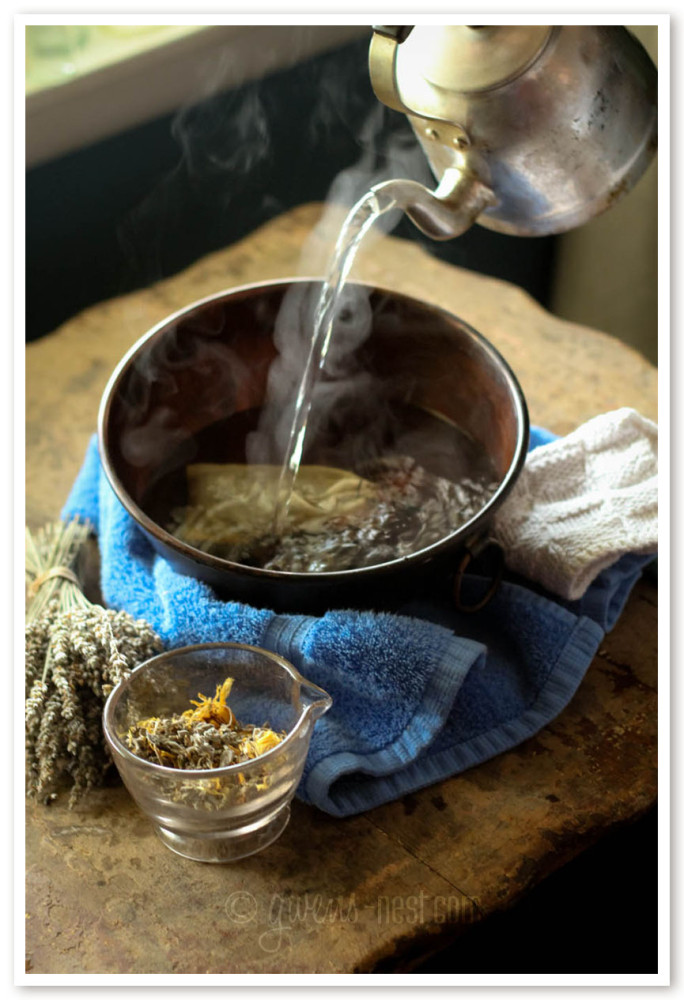
My favorite use for this tea was for in the frozen postpartum compresses. I made them at home, and let my midwife know that we were going to use them immediately after our birth. We took the frozen herbal compresses (pads) to the hospital in a little cooler, and my midwife let me use one of the frozen pads immediately after the birth of my son. I continued to swap them out for new ones a full 24 hours after delivery for comfort. I believe they made the biggest difference in my healing time, and my nurses (though curious) were very impressed at how quickly I was healing. I highly recommend this as a part of any postpartum recovery!
To make a postpartum herbal bath tea for a sitz pan or peri bottle: Pour 8 cups boiling water over 1 cup of tea : steep for at least 20 minutes (or overnight for the strongest infusion). Strain out herbs and discard. I use a tea towel or coffee filter in my strainer, or use cloth bags to keep the herbs from leaking through. You can also tie the herbs up in a coffee filter. Refrigerate unused portion, and use within 2 days or freeze.
To use in a regular bath: Tie up 1 cup of herb blend in a coffee filter. Steep in 2 cups boiling water for at least 20 minutes or overnight for the strongest infusion. Squeeze the herb packet out into the tea after it’s done steeping. Add to your bath water, and enjoy a relaxing soak.
To make frozen compresses: Tie 1/2 cup of tea into a coffee filter or reusable cloth bag. Steep in 2 cups of boiling water for at least 20 minutes, or overnight for strongest infusion. Line a cookie sheet with feminine pads of your choice. I like these 100% Organic Cotton Pads. (this is my affiliate link through Amazon)
Pour tea mixture over pads and allow the liquid to absorb. Freeze. Once frozen, pads can be placed in an airtight bag in the freezer and used as needed.
To make warm compresses: Follow brewing instructions for frozen pads above, but apply warm tea over a pad and allow it to soak in. Use immediately. Keep additional tea in the fridge and warm as needed to make additional compresses.
Supplies
The following supplies can be purchased through my affiliate links via Mountain Rose Herbs, or Amazon. Affiliate links always mean that you pay the same prices I would, allows me to recommend my favorite products and stores, and saves you the time of looking up products. If you shop through my affiliate links, I make a small commission to support what I’m doing here. So thank you! 🙂
Remember that you don’t have to have *every* herb called for, but you can pick and choose your favorites. Here are all of the lovely herbs and what they do:

- Comfrey– contains a component called allantoin that speeds up cell proliferation & encourages healing.
- Shepherd’s Purse– often used to help inhibit bleeding and to stimulate muscle tone and contractions.
- Salt– saltwater is notorious for inhibiting bacteria and promoting healing.
- Uva Ursi– antibacterial, astringent and tissue toning, and reduces inflammation.
- Calendula– a renown herb for skin health- but gentle enough for a baby
- Yarrow– this is a wonderful toning herb that has shown antimicrobial actions
- Lavender Flowers– lavender is an herb that’s traditionally used for women, and skin health. I love it for the scent too!
- Plantain– this little powerhouse herb is an astringent and wonderful for skin health among other things. I love plantain for many other uses, and keep it on hand.
- Marshmallow Root– this is a demulcent herb that’s very soothing to tissues.
- Chickweed– also a demulcent and cooling herb that speeds healing and soothes inflamed tissues.
- Their large (4×6 size) cotton muslin bags with drawstrings make excellent and simple tea bags that would be strong enough to use for a warm compress after brewing. And they’re washable too!
- To make herbal postpartum care pads, I recommend either 14″ overnight cloth pads, or these chlorine free disposables.
Have you used herbs to provide postpartum care? I’d love to hear your story of recovery using natural remedies in the comments. Thank you for pinning and sharing this post!
Follow me on Pinterest and never miss a natural remedy!
Follow Gwen’s Nest’s board Gwen’s Nest Herbs & Natural Health on Pinterest.


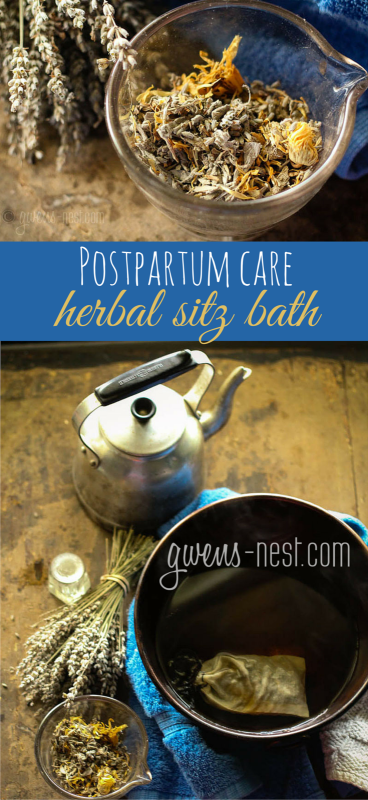
.jpg)
Thanks for this post. I will definately try this for my next birth. I do worry about post partum bleeding and uterus clamping down well enough. I heard shepherds purse is good for this. With my last birth (3rd) my uterus uncontracted a couple of times after the birth which was worrying despite improving my diet greatly. In the end I didn’t loose too much blood that needed any treatment but I did continue to bleed for 2.5 months. I think the bleeding should only last upto 6 weeks.
Apparently risk of bleeding more increases with every birth so I want to try this remedy for next time.
I didn’t fully understand it though- how do you use the frozen compress, where do you put it?
The tea is not to drink…it’s used as a wash or compress over the ‘delivery area’ (where baby just came from). 🙂
Look into using turmeric or cayenne (not for whimps) as styptic herbs for post-delivery bleeding. This was a concern for me as well.
Getting baby nursing right away, skin to skin, is so helpful for both Mama and baby. Baby gets all warm and cozy, and the prolactin that the suckling produces helps the womb contract.
A note for Canadian’s who are having a hard time finding some herbs locally. I put in an order with richters.com (they are close to Toronto). I’ve ordered from them before and have been happy with the product and delivery time.
Now thinking I should find some large tea bags so I can gift it to expectant mama’s. 😀
Thanks for finally writing about >Postpartum Care Herbal Sitz Bath | Gwen’s Nest
<Loved it!
These are so soothing.
Why don’t you just add the herbs(in a muslim bag) to the bathwater? Is the infusion better way to extract more of the herb? Thank you for the recipe and other tips!